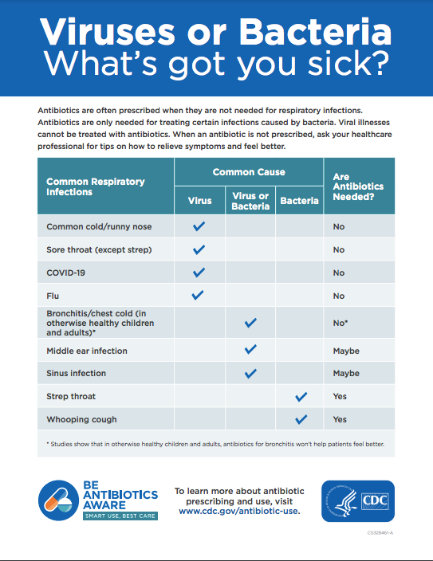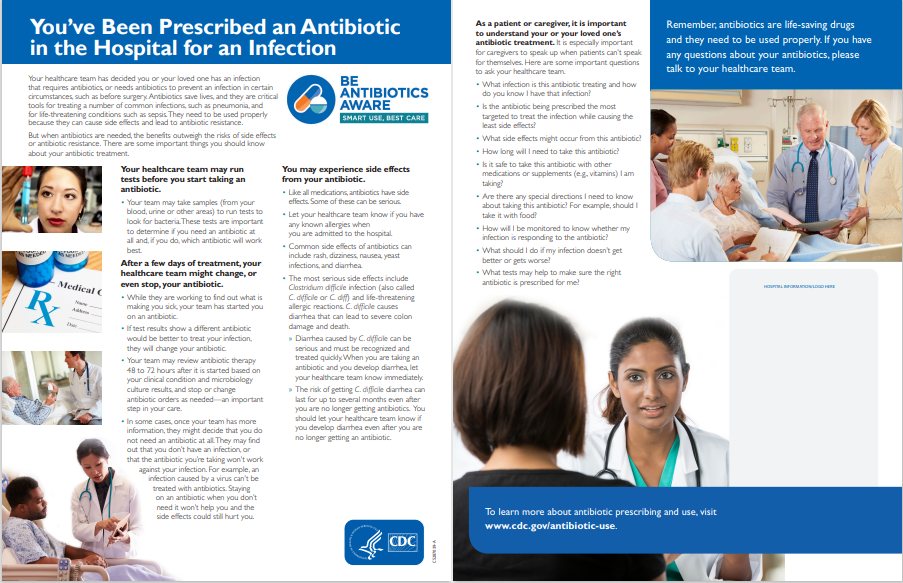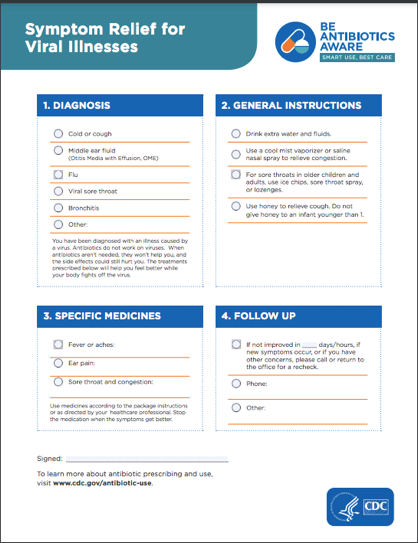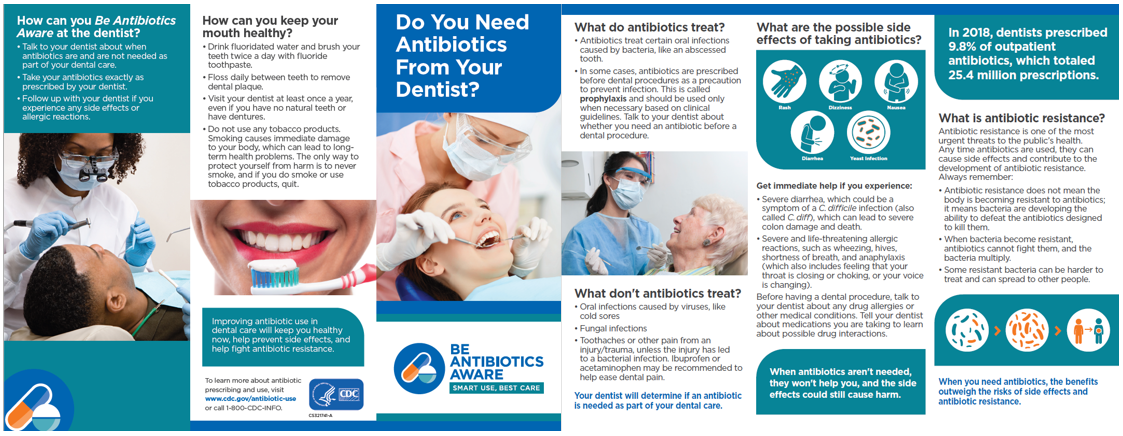BAA HCP Post Campaign Screener and Survey
[NCEZID] Assessment for the Be Antibiotics Aware Consumer Campaign
BAA HCP Post-Campaign web survey
BAA HCP Post-Campaign web survey
OMB: 0920-1387

Centers for Disease Control and Prevention
Division of Healthcare Quality Promotion
Be Antibiotics Aware (BAA)
HCP Posttest Survey
Prepared for DHQP by CATMEDIA
Table of Contents
classification of Respondents based on their responses to the screener questions 2
BAA HCP Screener Begins Here 4
baa HCP posttest SCREENER [ALL] 5
General Instructions for Programmer and Recruiter 7
End of Survey Message for posttest 7
Frequency and Channel of Exposure [EXPOSED ONLY] 8
Risks and Benefits of Antibiotics – Attitudes and Beliefs [ALL GROUPS EXCEPT PHARMACISTS] 12
Risks and Benefits of Antibiotics – Attitudes and Beliefs [PHARMACISTS ONLY] 14
Discussing Antibiotics with Patients: Attitudes, Beliefs and Behaviors [ALL EXCEPT PHARMACISTS] 16
KNOWLEDGE OF NEED FOR CONVERSATIONS 16
PERCEIVED BENEFITS OF CONVERSATIONS 16
Discussing Antibiotics with Patients: Attitudes, Beliefs, and Behaviors [PHARMACISTS ONLY] 18
KNOWLEDGE OF NEED FOR CONVERSATIONS 18
PERCEIVED BENEFITS OF CONVERSATIONS 19
Covid-19 Behavior [ALL Except dentists] 20
Use of Campaign Materials [EXPOSED ONLY] 20
Media Use and Habits [UNEXPOSED ONLY] 27
Demographic Characteristics [ALL] 30
HCP Intended Audiences
Dentists
Physicians and advanced practice providers in nursing homes
Nurses in nursing homes
Community pharmacists
Priority markets
classification of Respondents based on their responses to the screener questions
Respondents should be classified as “Hospitalists” if their response(s) to
Q8 = Physician (MD or DO), Physician Assistant (PA), or Nurse Practitioner (NP)
Q9 = Hospital AND
Q10 = 31 or more hours AND
Q11 = Once a week or multiple times every week
Respondents should be classified as “Dentists” if their response(s) to
Q8= Dentist (DDS or DMD)
Q9 = Dental office AND
Q10 = 31 or more hours AND
Q11 = Once a week or multiple times every week
Respondents should be classified as “Physicians and Advanced Practice Professionals (APPs) in Nursing Homes (NHs)” if their response(s) to
Q8 = Physician (MD or DO), Physician Assistant (PA), Nurse Practitioner (NP)
Q9 = Nursing home/Long Term Care AND
Q10 = 31 or more hours AND
Q11 = Once a week or multiple times every week
Respondents should be classified as “Nurses in NHs” if their response(s)
Q8 = Licensed Nurse (RN, BSN, LPN)
Q9 = Nursing home/Long Term Care AND
Q10 = 31 or more hours AND
Q11 = Once a week or multiple times every week
Respondents should be classified as “Community Pharmacists” if their response(s) to
Q8 = Pharmacist (PharmD or RPh)
Q9 = Pharmacy (Retail) AND
Q10 = 31 or more hours AND
Q11 = Once a week or multiple times every week
Tallgrass: Do not send a survey link to participants who did not fall under any intended audience group.
End of screener Message
Programmer: Present this message to participants who completed the screener.
Programmer: Customize the collector’s page with this message.
Thank you for answering the screening questions. If you are eligible to participate, you will receive an email with a copy of your signed informed consent and the link to take the survey. The incentive described in the informed consent will be available upon completion of the survey. If you have any questions or concerns, please contact Julie Overby at [email protected] or call phone number 253-238-7787 or 360-942-8466.
SCREENER Ineligibility Message
Programmer: Present this message to participants who do not give their consent and respondents who provide a response that makes them ineligible to continue with the survey.
Programmer: Customize the collector’s page with this message.
Thank you for your willingness to participate in this survey. Unfortunately, you are not eligible to proceed with the survey. If you have any questions, please contact Julie Overby at [email protected] or call phone number 253-238-7787 or 360-942-8466.
Thank you for your time.
BAA HCP Screener Begins Here
INFORMED CONSENT TO PARTICIPATE IN AN ONLINE SURVEY
On behalf of the Centers for Disease Control and Prevention (CDC), CATMEDIA, an Atlanta-based program management, training, and creative services company, is conducting an online survey with adults to gather feedback on educational materials related to antibiotic use. We hope to use what we learn from these survey results to improve these materials and/or how and where we promote them to raise awareness within your community. This is the screener. After you are determined as eligible to participate, you will only be asked to complete the survey once. We expect the survey to take about 20 minutes.
Your participation in this survey is completely voluntary. You may choose to skip questions that you do not want to answer and/or stop the survey at any time for any reason. Refusal to participate will not result in any penalties.
If you choose to participate in this survey, we will keep your answers private and will not share your personal information with anyone outside of the survey team.
At the end of the survey, you will receive $75 through Venmo or PayPal, or a $75 gift card as a token of our appreciation for your time. You should receive it within 7 business days.
If you have questions or need a copy of the informed consent, please email Julie Overby at [email protected] or call 253-238-7787 or 360-942-8466.
Please answer the question below and print a copy for your records before proceeding to the next page. If you select “Yes,” it means you understand the information in this consent form and that you agree to take the survey.
All questions with an asterisk [*] require a response.
* Do you agree to participate in this survey?
Yes
No
Programmer: If the respondent selects “Yes” to the question, “Do you agree to participate in this survey” present the next page for the respondent to enter their name as an electronic signature and date of consent.
If the respondent selects “No” terminate the survey and present the INELIGIBILITY MESSAGE.
* Enter your full name here.

* Enter today’s date here. (MM/DD/YYYY)

Programmer: If the respondent enters their name as an electronic signature and date of consent, do not terminate the survey.
baa HCP posttest SCREENER [ALL]
Programmer: Include one question per page. Screener should terminate as soon as the respondent selects an option that deems him/her ineligible.
Thank you for participating in this survey. The results of this survey will help the Centers for Disease Control and Prevention (CDC) refine and improve its ongoing campaign to improve antibiotic use.
OMB Statement
Form Approved
OMB No. 0920-1387
Expiration Date: 03/31/2026
Public reporting burden of this collection of information is estimated to average 20 minutes per response, including the time for reviewing instructions, searching existing data sources, gathering, and maintaining the data needed, and completing and reviewing the collection of information. An agency may not conduct or sponsor, and a person is not required to respond to a collection of information unless it displays a currently valid OMB Control Number. Send comments regarding this burden estimate or any other aspect of this collection of information, including suggestions for reducing this burden to CDC/ATSDR Reports Clearance Officer, 1600 Clifton Road NE, MS D-74, Atlanta, Georgia 30333; ATTN: PRA 0920-1387
Programmer: Include one question per page. Screener should terminate as soon as the respondent selects an option that deems him/her ineligible.
* May we ask you some questions to see if you are eligible to take this survey?
Yes
No [INELIGIBLE/TERMINATE]
Programmer: If “No” to Q4, TERMINATE else proceed with survey.
Are you a healthcare professional (e.g., physician, physician assistant, nurse practitioner, nurse, pharmacist, or dentist)?
Yes
No [INELIGIBLE/TERMINATE]
In what State do you perform the majority of your work? _____________________
Programmer: Create a dropdown option with all U.S. States and options for “Prefer not to answer” and “I cannot find my State.”
In what ZIP Code do you perform the majority of your work? _____________________
Programmer: Create a dropdown option with approved ZIP Codes and options for “Prefer not to answer” and “I cannot find my ZIP Code.”
Programmer: Priority markets include Iowa (IA), Nebraska (NE), Tennessee (TN), and Alabama (AL).
Programmer: If not within one of the priority markets and approved ZIP Codes, TERMINATE, otherwise, proceed with survey.
Specifically, what type of healthcare professional are you?
Physician (MD or DO)
Physician Assistant (PA)
Dentist (DDS or DMD)
Pharmacist (PharmD or RPh)
Nurse Practitioner (NP)
Registered Nurse (RN, including ADNs and BSNs)
None of the above [INELIGIBLE/TERMINATE]
* What type of setting do you spend the most time providing patient care?
Hospital
Nursing home/Long-Term Care
Retail pharmacy
Dental office
Urgent care facility [INELIGIBLE/TERMINATE]
Primary care practice/facility [INELIGIBLE/TERMINATE]
Outpatient [INELIGIBLE/TERMINATE]
None of the above [INELIGIBLE/TERMINATE]
* On average, how many hours a week do you provide patient care?
0-10 hours [INELIGIBLE/TERMINATE]
11-20 hours [INELIGIBLE/TERMINATE]
21-30 hours [INELIGIBLE/TERMINATE]
31 or more hours
* On average, how often do you prescribe antibiotics/provide antibiotics to patients?
Once a week
1-3 times a month [INELIGIBLE/TERMINATE]
Never [INELIGIBLE/TERMINATE]
General Instructions for Programmer and Recruiter
Hide all subheadings of sections and questions from respondents.
Hide all programmer’s instructions from respondents.
Terminate also means ineligible.
Terminate all ineligible respondents immediately.
Present the “Ineligibility Message” whenever a response terminates the survey.
RECRUITER: Terminate after quota for each category, audience, and/or group is met.
RECRUITER: Assign participants to only one intended audience group.
Ineligibility Message
Thank you for your willingness to participate in this survey. Unfortunately, you are not eligible to proceed with the survey. If you have any questions, please contact Julie Overby at [email protected] or call phone number 253-238-7787 or 360-942-8466.
Thank you for your time.
End of Survey Message for posttest
Programmer: Place this message in the collector’s page for custom thank you.
Thank you for taking the time to participate in this important survey!
To learn more about appropriate antibiotic use, please visit https://www.cdc.gov/antibiotic-use/
Programmer: Place this link in the collector’s page for custom URL to redirect all respondents to this link.
Link: https://www.cdc.gov/antibiotic-use/
Exposure to Campaign [ALL]
Programmer: Include one question per page.
Now we would like to ask you about a CDC campaign on appropriate antibiotic use that you may or may not have seen or heard about in the past 2-3 months.
Please indicate below whether you have seen or heard any of the following campaign names or slogans in the past 2-3 months.
Programmer: Rotate (a - e), the column named “Campaigns” among respondents.
-
CAMPAIGNS
Yes
No
Do not know/
cannot recallGet Ahead of Antibiotics
Flip the Script
Be Antibiotics Aware
Get Smart About Antibiotics
Don’t Miss-take Antibiotics
I
 n
the past
2-3 months,
did you see or hear this logo/slogan (“Be
Antibiotics Aware,”
“Smart Use, Best Care”)
anywhere?
n
the past
2-3 months,
did you see or hear this logo/slogan (“Be
Antibiotics Aware,”
“Smart Use, Best Care”)
anywhere?
Yes
No
Do not know/cannot recall
Programmer: Categorize respondents as “UNEXPOSED” only if the respondent selects “No,” “Do not know/cannot recall” or did not respond to Q1c and Q2, then proceed to the KNOWLEDGE section.
Respondents with any other combination should be “EXPOSED,” then proceed to FREQUENCY AND CHANNEL OF EXPOSURE section.
Frequency and Channel of Exposure [EXPOSED ONLY]
Programmer: Include one question per page.
You indicated that you had seen or heard the campaign name, Be Antibiotics Aware, or seen the campaign logo in the past 2-3 months.
In the past 2-3 months, approximately how often did you see or hear CDC’s Be Antibiotics Aware campaign messages, campaign name, or logo in …?
Programmer: Rotate the media options (Poster, Fact sheet, Brochure, etc.). Leave “Other” response last.
In the past 2-3 months, approximately how often did you see or hear CDC’s Be Antibiotics Aware campaign messages, campaign name, or logo on …?
Programmer: Rotate the media options (Facebook, Instagram, Twitter, etc.). Leave “Other” response last.
In the past 2-3 months, approximately how often did you see or hear CDC’s Be Antibiotics Aware campaign messages, campaign name, or logo in …?
Programmer: Rotate the media options (Online/Internet Media). Leave “Other” response last.
In the past 2-3 months, approximately how often did you see or hear CDC’s Be Antibiotics Aware campaign messages, campaign name, or logo on …?
Programmer: Rotate the media options (TV and Radio Media). Leave “Other” response last.
In the past 2-3 months, how often did you see or hear CDC’s Be Antibiotics Aware campaign messages, campaign name, or logo in …?
Programmer: Rotate the media options (Public Places). Leave “Other” response last.
In the past 2-3 months, did you see or hear CDC’s Be Antibiotics Aware campaign messages, campaign name, or logo at your workplace (including at your home workplace for telework)?
Yes, I personally placed or shared CDC’s Be Antibiotics Aware Campaign materials at my workplace in the past 2-3 months
Yes, I saw CDC’s Be Antibiotics Aware Campaign at my workplace in the past 2-3 months, but I was not responsible for placing or sharing it
No, but I saw materials from another antibiotic use campaign at my workplace in the past 2-3 months
No, I have not seen any materials about antibiotic use at my workplace in the past 2-3 months
Programmer: If the respondent selects “Yes” to the question above, proceed to the next question.
In the past 2-3 months, where did you see or hear CDC’s Be Antibiotics Aware campaign messages, campaign name, or logo at your workplace (including at your home workplace for telework)? Select all that apply.
Posters or other print material(s) designed to educate patients about appropriate antibiotic use
Posters or other print material(s) designed to improve antibiotic prescribing by healthcare professionals
Digital material(s) designed to educate patients about appropriate antibiotic use
Digital material(s) designed to improve antibiotic prescribing by healthcare professionals
Video displays in patient waiting areas
Workplace website or internal email/newsletter
Email or e-newsletter from an external health organization, such as a state or local public health agency or professional association
Other, please specify below:
Do not know/cannot recall [Programmer: Lock response.]
Programmer: If the respondent is presented the question above, after responding or if they choose to skip, proceed to “RISKS AND BENEFITS...” section.
You indicated that you saw or heard the campaign name, Be Antibiotics Aware, or saw the campaign logo in the past 2-3 months. Where did you see or hear it? [Open-ended response]

Programmer: If the respondent leaves the above open-ended question blank, reclassify these respondents as “UNEXPOSED” and proceed to “RISKS AND BENEFITS...” section.
Risks and Benefits of Antibiotics – Attitudes and Beliefs [ALL GROUPS EXCEPT PHARMACISTS]
Programmer: Include one question per page. Include disclaimer statement below only with the first question in this section. Do not allow participants to go back and change their response to a previous question.
NOTE**Subheadings within all tables should not be visible to respondents.
Next, we are going to ask you some questions to learn more about your perspective on antibiotic prescribing. Research shows that healthcare professionals face challenges with antibiotic prescribing. Your responses to this survey will help CDC understand how to better support healthcare professionals’ antibiotic prescribing habits. Please give us your honest responses. There are no right or wrong answers to any of these questions.
Please indicate the extent to which you agree with the following statements, from strongly disagree to strongly agree.
-
PERCEIVED SEVERITY
Strongly Disagree
Disagree
Neither
Agree nor Disagree
Agree
Strongly Agree
Antibiotic resistance is a serious public health issue.
Antibiotic resistance can have serious consequences for my patients.
Side effects caused by antibiotics could be very serious for my patients.
Please indicate the extent to which you agree with the following statements, from strongly disagree to strongly agree.
-
PERCEIVED SUSCEPTIBILITY
Strongly Disagree
Disagree
Neither
Agree nor Disagree
Agree
Strongly Agree
If my patients are prescribed antibiotics, they could experience minor side effects, like a rash.
If my patients are prescribed antibiotics, they could experience very serious health problems, such as Clostridioides difficile (or C. diff) infection.
Please indicate the extent to which you agree with the following statements, from strongly disagree to strongly agree.
PERCEIVED BENEFITS
Strongly Disagree
Disagree
Neither
Agree nor Disagree
Agree
Strongly Agree
Prescribing antibiotics judiciously and only for certain infections caused by bacteria is the best care for my patients.
Prescribing antibiotics judiciously and only for certain infections caused by bacteria helps protect my patients from unnecessary antibiotic use.
Prescribing antibiotics judiciously and only for certain infections caused by bacteria helps combat antibiotic resistance.
In the past 2-3 months, please indicate how often you did the following when prescribing antibiotics.
-
BEHAVIOR (PRESCRIBING)
Never
Rarely
Sometimes
Often
Always
I factor patient satisfaction into my decisions to prescribe antibiotics.
I prescribe antibiotics according to clinical guidelines.
I consider antibiotic resistance when prescribing an antibiotic to my patients.
I take antibiotic resistance into consideration when choosing which antibiotic to prescribe to my patients.
I consider antibiotic adverse events, like C. diff infection, when prescribing antibiotics to my patients.
What barriers do you commonly experience in prescribing antibiotics to your patients? Select all that apply.
Current clinical guidance does not always apply to my patients
I am not as familiar as I would like to be with current clinical guidance for prescribing antibiotics
My patients will be dissatisfied with their visit if I do not prescribe antibiotics and they believe they need them for their illness
My patients demand antibiotics, even if I don’t think an antibiotic is needed to treat their illness
My patients are not concerned about antibiotic resistance
My patients are unconcerned about potential side effects of antibiotics, such as rash, nausea, or C. diff infection
My patients are unaware of potential side effects of antibiotics, such as rash, nausea, or C. diff infection
Uncertainty of diagnosis can make it challenging to determine if the patient needs antibiotics
Other, please explain below:
I have not encountered any barriers to following clinical guidelines regarding antibiotic prescribing [Programmer: Lock response.]
Risks and Benefits of Antibiotics – Attitudes and Beliefs [PHARMACISTS ONLY]
Please indicate the extent to which you agree with the following statements, from strongly disagree to strongly agree.
-
PERCEIVED SEVERITY
Strongly Disagree
Disagree
Neither
Agree nor Disagree
Agree
Strongly Agree
Antibiotic resistance is a serious public health issue.
Antibiotic resistance can have serious consequences for my patients.
Side effects caused by antibiotics could be very serious for my patients.
Please indicate the extent to which you agree with the following statements, from strongly disagree to strongly agree.
-
PERCEIVED SUSCEPTIBILITY
Strongly Disagree
Disagree
Neither
Agree nor Disagree
Agree
Strongly Agree
If my patients are prescribed antibiotics, whether needed or not needed, they could experience minor side effects, like a rash.
If my patients are prescribed antibiotics, whether needed or not, they could experience very serious health problems, such as Clostridioides difficile (or C. diff) infection.
Please indicate the extent to which you agree with the following statements, from strongly disagree to strongly agree.
-
PERCEIVED BENEFITS
Strongly Disagree
Disagree
Neither
Agree nor Disagree
Agree
Strongly Agree
Providing antibiotics judiciously only for certain infections caused by bacteria helps combat antibiotic resistance.
Discussing Antibiotics with Patients: Attitudes,
Discussing Antibiotics with Patients: Attitudes, Beliefs and Behaviors [ALL EXCEPT PHARMACISTS]
Programmer: Include one question per page. Do not allow participants to go back and change their answer to a previous question.
Please indicate the extent to which you agree with the following statements, from strongly disagree to strongly agree.
-
KNOWLEDGE OF NEED FOR CONVERSATIONS
Strongly Disagree
Disagree
Neither
Agree nor Disagree
Agree
Strongly Agree
It is important for me to discuss with my patients that antibiotics can cause side effects that can range from minor issues, like a rash, to adverse events, such as C. diff infection.
It is important for me to discuss with my patients that antibiotic use can contribute to antibiotic resistance.
It is important for me to help my patients understand ways they can feel better, such as taking over the counter (OTC) medications that can help relieve symptoms, regardless of whether an antibiotic is needed to treat their illness.
It is important for me to educate patients about when antibiotics are and are not needed for their illness.
Please indicate the extent to which you agree with the following statements, from strongly disagree to strongly agree.
-
PERCEIVED BENEFITS OF CONVERSATIONS
Strongly Disagree
Disagree
Neither
Agree nor Disagree
Agree
Strongly Agree
I believe that educating my patients about appropriate antibiotic use can protect them from unnecessary side effects.
I believe that educating my patients about appropriate antibiotic use can help reduce unnecessary antibiotic use, thus helping to combat antibiotic resistance.
I believe that educating my patients about which infections antibiotics do and do not treat helps them understand my decision on whether to prescribe antibiotics for their illness.
When prescribing antibiotics, please indicate how frequently you discuss the following with your patients.
-
BEHAVIOR (CONVERSATIONS)
Never
Rarely
Sometimes
Often
Always
Whether antibiotics are needed for their illness.
Other ways to feel better, such as taking OTC medications that can help relieve symptoms, including when a patient has an infection that does not need an antibiotic.
Common side effects, such as rash, diarrhea, and nausea, when prescribing antibiotics.
Possible severe side effects, such as C. diff infection or allergic reactions.
Antibiotic use contributes to antibiotic resistance.
What are the barriers you commonly encounter when educating your patients on the topics of appropriate antibiotic use and antibiotic resistance? Select all that apply.
I am not familiar enough with these topics
I do not feel confident educating my patients on these topics
I do not think my patients will understand these topics
I do not think it is important for my patients to understand these topics
I do not think my patients will be interested in or receptive to learning about these topics
I do not have time to educate my patients on these topics
I do not have access to educational materials about these topics
Other, please specify below:
I have not encountered any barriers to educating my patients on these topics [Programmer: Lock response.]
Did you know that CDC’s Be Antibiotics Aware campaign has resources you can use to help educate your patients about appropriate antibiotic use?
Discussing Antibiotics with Patients: Attitudes, Beliefs, and Behaviors [PHARMACISTS ONLY]
Please indicate the extent to which you agree with the following statements, from strongly disagree to strongly agree.
-
KNOWLEDGE OF NEED FOR CONVERSATIONS
Strongly Disagree
Disagree
Neither
Agree nor Disagree
Agree
Strongly Agree
It’s important for me to discuss with my patients that antibiotic use can lead to antibiotic resistance.
It is important for me to help my patients understand ways they can feel better, such as taking over the counter (OTC) medications that can help relieve symptoms, including when an antibiotic is not needed to treat their illness.
It is important for me to educate my patients about when antibiotics are and are not needed for their illness.
Please indicate the extent to which you agree with the following statements, from strongly disagree to strongly agree. Educating includes providing verbal or written information on how to take antibiotics correctly.
-
PERCEIVED BENEFITS OF CONVERSATIONS
Strongly Disagree
Disagree
Neither
Agree nor Disagree
Agree
Strongly Agree
I believe that educating my patients about appropriate antibiotic use can protect them from common side effects, such as rash, diarrhea, and nausea.
I believe that educating my patients about appropriate antibiotic use can protect them from more serious side effects, including life-threatening allergic reactions or C. diff infection.
I believe that educating my patients about viral vs. bacterial causes of acute respiratory infections (ARI), including COVID-19, can help reduce unnecessary antibiotic use.
I believe that educating my patients about appropriate antibiotic use can help reduce unnecessary antibiotic use, thus helping to combat antibiotic resistance.
When prescribing antibiotics, please indicate how frequently you discuss the following with your patients.
-
BEHAVIOR (CONVERSATIONS)
Never
Rarely
Sometimes
Often
Always
N/A
Common side effects, such as rash, diarrhea, and nausea.
More serious side effects, such as C. diff infection.
The threat of antibiotic resistance.
The importance of taking antibiotics as prescribed.
Did you know that CDC’s Be Antibiotics Aware campaign has resources you can use to help educate your patients about appropriate antibiotic use?
Yes
No
Covid-19 Behavior [ALL Except dentists]
In the past 12 months, how often did you feel patients expected you to provide antibiotics because they believed they had COVID-19?
Always
Often
Sometimes
Rarely
Never
I did not see any patients who believed they had COVID-19 [Programmer: Lock response.]
In the past 12 months, how often did your patients specifically ask for antibiotics because they believed they had COVID-19?
Always
Often
Sometimes
Rarely
Never
I did not see any patients who believed they had COVID-19 [Programmer: Lock response.]
In the past 12 months, how often did you provide antibiotics to patients to treat COVID-19?
Always
Often
Sometimes
Rarely
Never
I did not see any patients who believed they had COVID-19 [Programmer: Lock response.]
Use of Campaign Materials [EXPOSED ONLY]
Have you been contacted by any of these organizations in the last 2-3 months about Be Antibiotics Aware?
Local Health Department, please specify below:
State Health Department, please specify below:
Other, please specify below:
None of these organizations [Programmer: Lock response.]
Did your partners provide any of these campaign materials for you to use to help educate your patients on appropriate antibiotic use? Select all that apply.
Chart
Fact sheet
Prescription pad
Brochure
None of the above
Programmer: If the respondent selects “none of the above” in the above question, skip to the last question in this section.
Programmer: only show campaign images and their corresponding questions to respondents who select them in the above question.
Programmer: Put a page break here.
A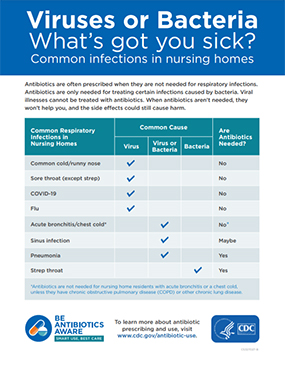
Please select how often in the past 2-3 months you used this chart to educate your patients about when antibiotics are and are not needed for their illness.
Always
Often
Sometimes
Rarely
Programmer: Put a page break here.
Please select how often in the past 2-3 months you used this chart to educate your patients about risks and benefits of antibiotic use.
Always
Often
Sometimes
Rarely
Programmer: Put a page break here and skip logic.
How helpful for you was this chart in educating your patients about appropriate antibiotic use?
Very helpful
Helpful
Somewhat helpful
A little helpful
Not at all helpful
Programmer: Put a page break here and skip logic.

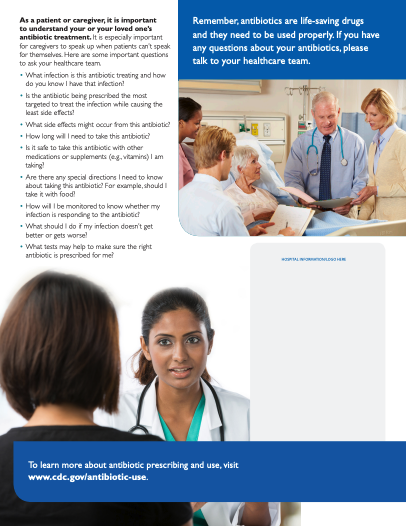
B
Please select how often in the past 2-3 months you used this fact sheet to educate your patients about when antibiotics are and are not needed for their illness.
Always
Often
Sometimes
Rarely
Programmer: Put a page break here.
Please select how often in the past 2-3 months you used this fact sheet to educate your patients about risks and benefits of antibiotic use.
Always
Often
Sometimes
Rarely
Programmer: Put a page break here and skip logic.
How helpful for you was this fact sheet in educating your patients about appropriate antibiotic use?
Very helpful
Helpful
Somewhat helpful
A little helpful
Not at all helpful
Programmer: Put a page break here and skip logic.
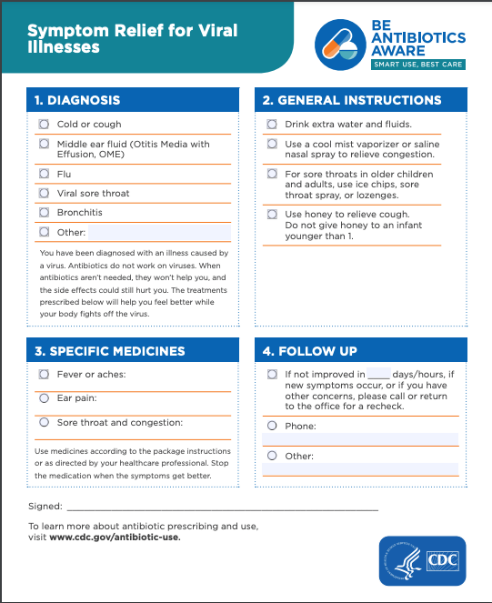
C
Please select how often in the past 2-3 months you used this prescription pad to educate your patients about when antibiotics are and are not needed for their illness.
Always
Often
Sometimes
Rarely
Programmer: Put a page break here.
Please select how often in the past 2-3 months you used this prescription pad to educate your patients about risks and benefits of antibiotic use.
Always
Often
Sometimes
Rarely
Programmer: Put a page break here and skip logic.
How helpful for you was this prescription pad in educating your patients about appropriate antibiotic use?
Very helpful
Helpful
Somewhat helpful
A little helpful
Not at all helpful
Programmer: Put a page break here and skip logic.
D
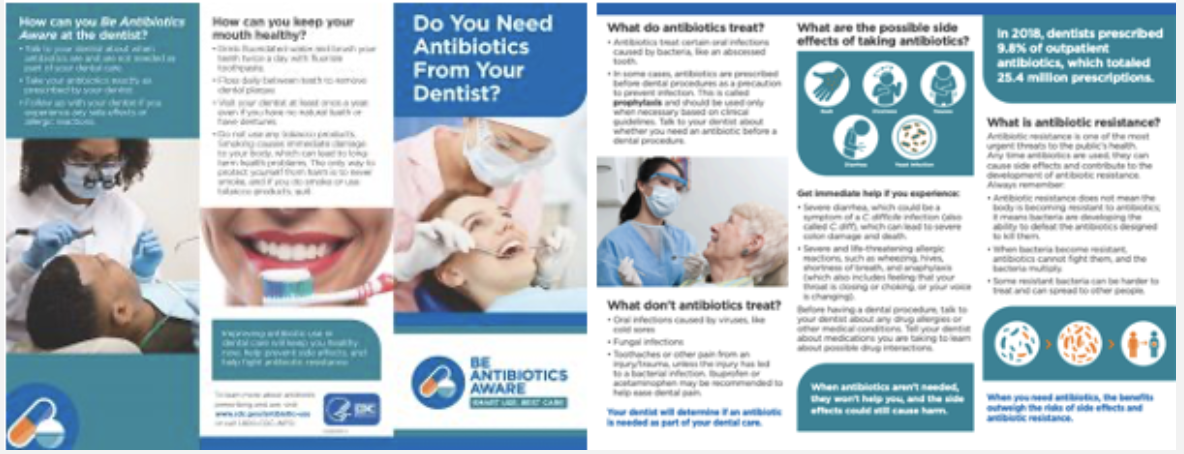
Please select how often in the past 2-3 months you used this brochure to educate your patients about when antibiotics are and are not needed for their illness.
Always
Often
Sometimes
Rarely
Programmer: Put a page break here
Please select how often in the past 2-3 months you used this brochure to educate your patients about risks and benefits of antibiotic use.
Always
Often
Sometimes
Rarely
Programmer: Put a page break here and skip logic.
How helpful for you was this brochure in educating your patients about appropriate antibiotic use?
Very helpful
Helpful
Somewhat helpful
A little helpful
Not at all helpful
Programmer: Put a page break here and skip to demographics section.
Why have you not used CDC’s Be Antibiotics Aware resources to educate your patients about appropriate antibiotic use? Select all that apply.
I did use CDC’s Be Antibiotics Aware resources to educate my patients/patients, but they were not the ones shown previously. Please specify below which resources you used
I do not usually use patient education resources when educating my patients/patients on any topics
I/my organization has my/our own resources
I use resources developed by other organizations
I forget to use them
I do not have time to use them
I do not know where to find these resources
I looked at them but did not find them helpful
I am not familiar enough with these resources to feel comfortable using them
Other, please specify below:
Do not know
Programmer: Put a page break here and skip to demographics section.
Media Use and Habits [UNEXPOSED ONLY]
Programmer: Include one set of questions (e.g., printed media, social media) per page. Rotate all media options.
We would like to ask you a few questions about your media use and habits.
In an average month, how often do you…
-
PRINTED MEDIA
1-2 times a day
Once a week
1-3 times a month
Less than once a month
Never
Do not know/
cannot recall
Read printed magazines
Read printed newspapers
Read brochures or flyers on health-related topics
Read other printed media, please specify below:
In an average month, how often do you…
-
SOCIAL MEDIA
1-2 times a day
Once a week
1-3 times a month
Less than once a month
Never
Do not know/
cannot recall
Use Facebook
Use Instagram
Use Twitter
Use LinkedIn
Use Doximity
Use Sermo
Use YouTube
Use other social media, please specify below:
In an average month, how often do you…
-
ONLINE/INTERNET MEDIA
1-2 times a day
Once a week
1-3 times a month
Less than once a month
Never
Do not know/
cannot recall
Read health websites /resources
Read news online
Read magazines online
Listen to internet radio
Watch TV/movies using streaming services (e.g., Netflix, Hulu, [Amazon] Prime Video)
Read blogs
Streaming internet radio
Search engines (e.g., Google)
Visit other websites, please specify below:
In an average month, how often do you…
-
TV AND RADIO MEDIA
1-2 times a day
Once a week
1-3 times a month
Less than once a month
Never
Do not know/
cannot recall
Watch television (cable, satellite, or antenna)
Listen to broadcast radio
Listen to satellite radio
Watch or listen to other TV or radio media, please specify below:
In an average month, how often do you…
-
PUBLIC PLACES
1-2 times a day
Once a week
1-3 times a month
Less than once a month
Never
Do not know/
cannot recall
See billboards
Use buses, subways, or trains
Use taxi cabs
Shop in malls
Shop in grocery stores
Shop in pharmacies (e.g., CVS, Walgreens, Walmart)
Visit other public places, please specify below:
In an average month, how often do you…
-
OTHER MEDIA
1-2 times a day
Once a week
1-3 times a month
Less than once a month
Never
Do not know/
cannot recall
Read email newsletters from healthcare professional associations
Listen to webcasts or webinars related to my profession
Listen to podcasts
Attend live events (presentation at a conference)
Use other media, please specify below:
To whom or where do you go to learn about appropriate antibiotic prescribing? Select all that apply.
Colleagues, other HCPs
Centers for Disease Control and Prevention (CDC) website or material, please specify below:
Peer-reviewed journals (printed or online), please specify below:
Health websites/Health-related mobile apps (WebMD, Mayo Clinic, Medscape, UpToDate, etc.), please specify below:
Medical conferences, please specify below:
Local/state health departments
Medical or professional associations, please specify below:
My place of work or organization
Continuing education/medical education/training courses (CE/CME, etc.), please specify below:
Social media (Facebook, Instagram, Twitter, LinkedIn), please specify below:
Demographic Characteristics [ALL]
Programmer: Include one set of questions per page.
Thank you. Now we would like to know more about you.
How long have you worked as a healthcare professional performing the same duties as your current role?
Less than one year
1-5 years
6-9 years
10 or more years
Prefer not to answer
What sex were you assigned at birth, on your original birth certificate?
Male
Female
Refused
I don’t know
Do you currently describe yourself as male, female, or transgender?
Male
Female
Transgender
None of these
What is your ethnicity?
Hispanic or Latino
Not Hispanic or Latino
What is your race?
American Indian or Alaska Native
Asian
Black or African American
Native Hawaiian or Other Pacific Islander
White
Before you go, a $75 incentive through Venmo or PayPal, or a $75 gift card will be sent to you as a token of our appreciation for your time. You should receive it within 7 business days.
*Please choose your preferred method to receive your incentive and fill out the short form to receive your incentive or click “Exit” if you do not wish to receive incentive.
Venmo Programmer: Link this option to “Venmo page.”
PayPal Programmer: Link this option to “PayPal page.”
Gift card by mail Programmer: Link this option to “Gift card by mail page.”
Digital gift card Programmer: Link this option to “Digital gift card page.”
Exit (I do not wish to receive incentive) Programmer: Link this option to “End of Survey.”
Venmo Page
If you do not feel comfortable providing the information below, please contact Julie Overby at [email protected] or call 253-238-7787 or 360-942-8466.
First and Last Name:
Your Venmo username:
Your email associated with Venmo (optional but recommended):
Your phone number associated with Venmo (optional but recommended):
Programmer: Link this page to “End of Survey.”
PayPal Page
If you do not feel comfortable providing the information below, please contact Julie Overby at [email protected] or call 253-238-7787 or 360-942-8466.
First and Last Name:
Your email associated with PayPal (optional but recommended):
Your phone number associated with PayPal (optional but recommended):
Programmer: Link this page to “End of Survey.”
Gift card by mail Page
If you do not feel comfortable providing the information below, please contact Julie Overby at [email protected] or call 253-238-7787 or 360-942-8466.
First and Last Name:
*Address Line 1:
Address Line 2:
*Town/City:
*State/Territory
*ZIP/Postal Code:
Phone number (optional):
Email (optional):
Programmer: Link this page to “End of Survey.”
Digital gift card Page
If you do not feel comfortable providing the information below, please contact Julie Overby at [email protected] or call 253-238-7787 or 360-942-8466.
First and Last Name:
*Your email:
Your phone number:
Programmer: Link this page to “End of Survey.”
| File Type | application/vnd.openxmlformats-officedocument.wordprocessingml.document |
| File Modified | 0000-00-00 |
| File Created | 0000-00-00 |
© 2025 OMB.report | Privacy Policy
